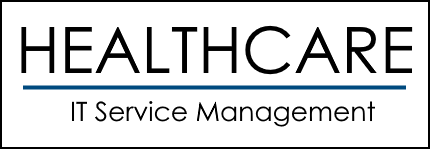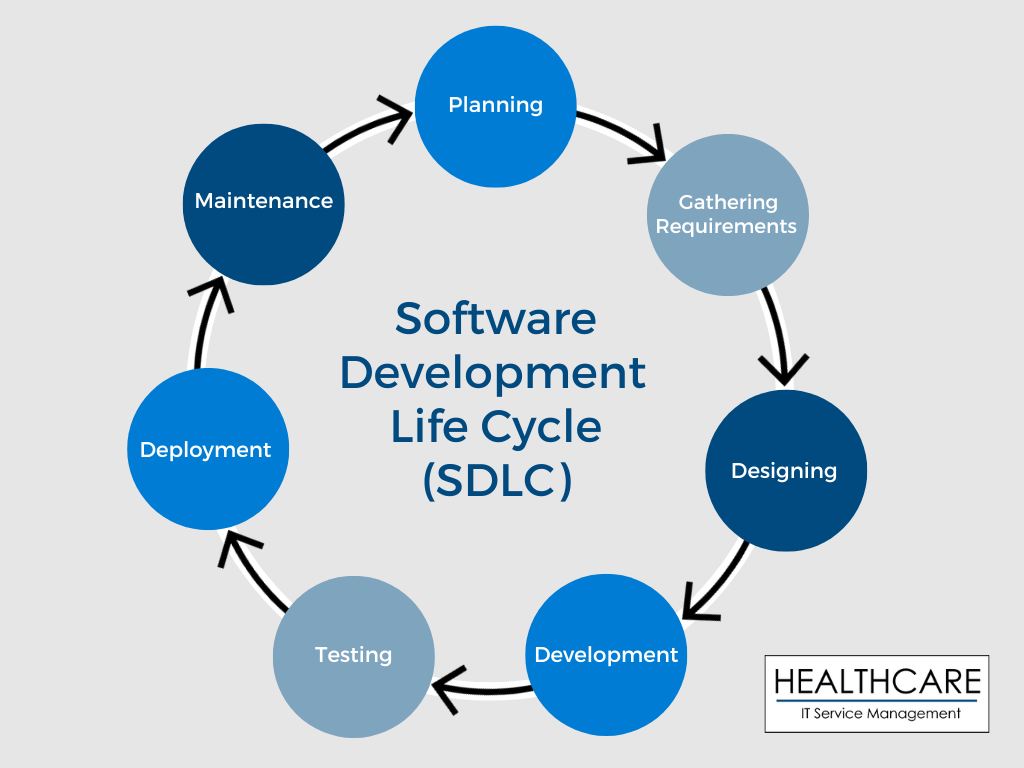Table of Contents
ToggleThe use of technology in the healthcare field is more critical than ever. Managing the financial assets needed for information technology (IT) can be a complicated process for healthcare businesses to navigate, but it is crucial if you want to receive a strong return on your investment (ROI). Unfortunately, failure to employ high-quality solutions can result in technical debt. In other words, by looking for faster solutions, your business may ultimately be forced to pay more to replace or update in the near future.
Our team at Healthcare ITSM can help you navigate this crucial decision-making process and assemble the most effective healthcare IT suite for your business. We understand how important budget is when implementing new solutions, and we’re prepared to help you meet your organization’s needs, regardless of size. Key in this set of decisions is the software development life cycle (SDLC).
What Is the Software Development Life Cycle?
The SDLC is the framework we use to reduce the overall cost of your healthcare business’s IT assets while creating high-quality software in a reasonable time frame. This is called a life cycle management system because this process is used throughout the software’s entire life cycle, from planning all the way to maintenance.
In most cases, SDLC consists of seven steps.
1. Planning
As expected, the planning phase involves project managers and consultants coming together to discuss various aspects of the project. We can help you determine cost estimates, schedules, and other elements needed to implement an effective system. The results desired are a primary focus, and consultants can help you outline what resources should and should not be considered, as well.
2. Gathering Requirements
After the planning phase has been completed, the team meets to gather anything they require for the project. If the team is upgrading older software, they may address any vulnerabilities that they want to be improved in the new software. Otherwise, the team will define all requirements that are needed to realize the various goals.
3. Designing
Once the requirements have been decided, a design plan is crafted. This outlines the specific technologies, time frames, resources, and more that are required to complete the project. At this point, we will ensure your healthcare IT will meet your goals and your budget without requiring additional investments that create technological debt.
4. Development
Once the project has been planned and designed, the team can begin development. During this stage, you are also involved in ensuring the software meets all requirements mentioned previously. This phase is complete when there is a functional version of the IT ready for testing.
5. Testing
Testing involves several different methods, including security, performance, code quality, integration, and more. Any bugs that weren’t discovered during development are identified and addressed before the software moves to the next phase.
6. Deployment
Once all technical issues have been solved, the software moves to the production phase. In most cases, this process is automated, but this is less common in smaller healthcare businesses. Some larger organizations may require additional sign-offs before the software can be deployed.
7. Maintenance
Once the software is deployed, the team continues to monitor the software for any additional bugs or vulnerabilities that were either missed or arose after it was deployed. The software is continuously improved and refined.
Why Are Life Cycle Management Systems Important?
SDLC models are important for several reasons in the healthcare field. Not only does the system provide a clear framework of operations, but it reduces costs that may otherwise be spent on unnecessary IT tools. During the planning stage, consultants and healthcare business managers can discuss needs and estimates, and anything that isn’t conducive to efficient patient care, billing, or operations can be factored out of the budget. Financial management in healthcare is crucial in ensuring the best results for not only your business but your patients as well.
How SDLC Reduces Costs
As mentioned previously, SDLC solutions can help reduce overall costs for healthcare organizations. Without SDLC, organizations may overspend on resources that are inefficient, redundant, inadequate, or useless in a particular use case. By consulting with a financial IT management consultant to carefully plan IT to achieve your goals, the use of SDLC can cut down on costs, allowing your business to allocate funds toward other areas that need them.
Another advantage of SDLC is the ability to test your software in the market before fully deploying it. You may not have this luxury without a framework, and if testing goes poorly, you won’t face the high volume of losses of a poorly planned system early. If consultants or your IT team test the new IT and find it ineffective, you can continue development and testing without overspending. Likewise, if they find your solutions adequate, you can continue with the framework’s process.
One other crucial factor of SDLC in healthcare IT financial management is how your SDLC prioritizes features. When you have patients relying on your IT systems, you can’t simply hope your solutions will work, especially if you’ve failed to prioritize the most crucial features of your framework.
SDLC will ensure you prioritize the following types of features:
- Features that closely align with business goals.
- Features your organization and its patients need most.
What Happens When You Don’t Utilize SDLC?
Some organizations may feel they don’t need to adhere to a specific framework when it comes to ITFM. Financial management in healthcare is essential for healthcare organizations to meet their goals while treating patients effectively, but this becomes more difficult without an idea of what you want to achieve. By ignoring or refusing to use life cycle management, your organization could experience technical debt.
Technical debt, sometimes referred to as “tech debt,” doesn’t necessarily mean poor or ineffective software that relies on cryptic code or messy frameworks. Technical debt in healthcare IT financial management is the result of a healthcare organization’s prioritization of quick IT solutions and low initial costs.
Unfortunately, an intense focus on low cost and speedy implementation can result in the need to make expensive changes much sooner than you anticipated. For example, if you rush the implementation of a poorly planned IT system that’s riddled with vulnerabilities, your organization may struggle to find the tools and financial resources needed to address the issue and roll out a replacement. This debt can doom your IT budget.
It’s worth mentioning that tech debt is also less visible to unseasoned healthcare business professionals compared to standard financial debt. In particular, healthcare businesses that frequently roll out new IT solutions due to pressure to match competitors may not experience the full effects of tech debt until several cycles of new solutions have failed to meet patient needs.
Since tech debt frequently occurs when an organization focuses on deployment speed rather than efficient, high-quality IT frameworks, SDLC is an important way of avoiding tech debt pitfalls. Failure to invest in SDLC can result in additional recurring costs as you attempt to optimize each piece of your IT framework separately.
How Consultants Can Improve Life Cycle Management
Technology has become increasingly more complex, and it can be challenging to both manage your current software and analyze the necessary data to improve. Your organization’s top priority should be administering the best treatment possible to your patients, not addressing software inefficiencies. This in itself can cut into your time and drain your budget, both of which should be spent helping patients. Hiring consultants can help you optimize your IT framework and tighten your IT budget, both now and as your business moves into the future.
What Are Financial IT Consultants?
A financial IT consultant is responsible for helping businesses make strategic financial decisions to establish IT and address any technical issues that may arise. Consultants work to understand your organization’s goals and provide solutions and advice to help you achieve these goals. Consultants may recommend certain tools, train current or potential employees, implement new software, and more. This includes the ability to improve or manage life cycle management systems.
Why Hire Consultants?
It may seem like hiring consultants may put a dent in your budget. However, the long-term benefit of financial IT consultants is that they can help you avoid tech debt and help your business maintain its budget more effectively.
Increased efficiency is arguably the most significant advantage of hiring consultants. They can ensure your business isn’t wasting time and money on solutions that aren’t optimized while providing strategies to address these flaws. The overall process of developing and employing technology becomes more streamlined, which not only helps your business practically but also reduces some of the stress in the work environment as well.
Consultants can also help reduce the costs of IT solutions in your business. If you’re not an expert in the IT field, or if you’re unsure how to start a project from scratch, you may spend additional time and money finding products that may not achieve the results you want. By working with a consultant to institute the ideal framework from the start, you can reduce future maintenance costs without the need to hire permanent staff.
Overall, consultants eliminate any unnecessary risks that you could face if you choose to address your IT needs on your own.
Who Can Use Healthcare IT Financial Management?
Healthcare businesses encompass a range of sizes and specialties, all the way from startups to enterprise-level corporations. Performing tasks like choosing software products, integrating new IT choices with current systems, troubleshooting IT issues, and performing ongoing maintenance is an essential component of any healthcare business’s IT plan. Just as important is ensuring each of these actions is the right choice from the start to avoid becoming entrenched in tech debt.
For a startup, for example, IT financial management consultants enable your healthcare business to optimize these decisions and put them into action without the need to hire full-time ITFM staff. At the enterprise level, consultants can help you ensure a cost-effective, long-range framework – and the resources you need to continue managing your IT roadblocks and budget – are in place before you ever set foot in the C-suite. Healthcare businesses of all sizes must remain cost-efficient to ensure effective patient care, and IT financial management consulting can help you achieve it.
Healthcare ITSM: Your Solution for IT Financial Management
Financial management in healthcare can be a daunting topic to consider, but consulting with Healthcare ITSM can ensure you mitigate your IT cost concerns by implementing the right IT solutions from the start.
When consultants work with you to implement life cycle management tools, you can carefully plan out exactly what your organization needs, as well as identify elements that are unnecessary for your project. This saves your business time and money that can be allocated toward providing patients with exceptional care. Consulting with Healthcare ITSM can help you ensure you’re making the best decisions possible, address practical IT matters, and prevent tech debt from hindering your budget.
If you own a healthcare organization and are looking to optimize your IT framework and streamline your budget, healthcare IT financial management consulting solutions from Healthcare ITSM can help. Whether you’re just starting out or have been in the healthcare field for decades, our team can help you implement new solutions that satisfy both your employees and patients.
To learn more about how we can help, contact our team today.

With over 16 years in the industry, Jameson Lee has honed his skills in IT management, project execution, and strategic planning. His ability to align technology initiatives with business goals has consistently delivered remarkable results for organizations across various sectors.
Jameson’s educational background includes an Associate of Applied Science degree in Computer Networking Systems, providing him with a solid foundation in technical concepts and best practices. Complementing his technical acumen, he has also completed coursework in Business Administration, equipping him with a well-rounded understanding of the operational aspects of running successful businesses.
Driven by a commitment to staying ahead of industry trends, Jameson actively pursues professional certifications and continuous learning opportunities. His credentials include CompTIA A+, N+, and Security+, along with MCP and MCTS certifications. This dedication ensures that he remains at the forefront of technological advancements, enabling him to offer innovative solutions to complex challenges.
What sets Jameson apart is his personable approach to working with clients. He believes in fostering strong relationships and effective communication, collaborating closely with stakeholders to understand their unique needs, and provide tailored technology solutions. By building trust and understanding, Jameson ensures that every project is aligned with the client’s vision and objectives.
Throughout his career, Jameson has successfully led teams and implemented robust frameworks to optimize performance and achieve remarkable technological initiatives. Whether it’s streamlining operations, enhancing cybersecurity measures, or implementing cutting-edge software solutions, Jameson has consistently delivered tangible outcomes for his clients.
As a trusted IT partner, Jameson’s mission is to empower businesses with technology solutions that drive growth, efficiency, and competitive advantage. With his expertise, dedication, and personable approach, Jameson Lee is the catalyst for transforming your business through the power of technology.




